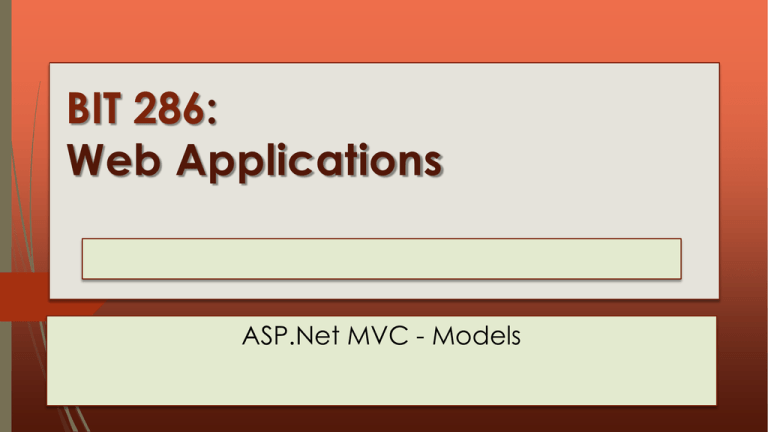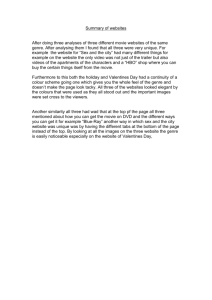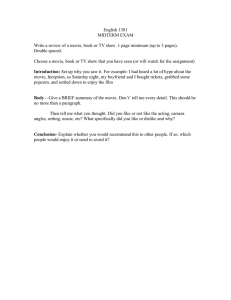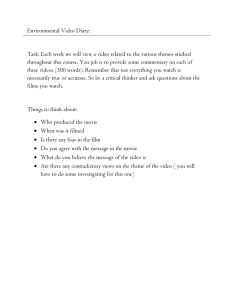Lecture 4 PowerPoint
advertisement

BIT 286:
Web Applications
Lecture 04: Thursday, January 15, 2015
ASP.Net MVC - Models
2
First Steps With Model
https://docs.asp.net/en/latest/tutorials/
first-mvc-app/adding-model.html
If you copy and paste the above you’ll get a 404 because of the newline after tutorials/ delete the space (or the %20, once you’re looking at the 404) and try again.
Setting up the POCO / POJO, managed DB access
Custom connection (to LocalDB, but could be to elsewhere)
Scaffolding: Free CRUD!
Examining the index page
3
EF sets up your DB with “Code First”
“The Entity Framework (often referred to as EF) supports
a development paradigm called Code First. Code First
allows you to create model objects by writing simple
classes. (These are also known as POCO classes, from
"plain-old CLR objects.") You can then have the
database created on the fly from your classes, which
enables a very clean and rapid development workflow.”
–Getting Started With MVC
Database first is still an option
4
C# Class definition
Create a plain old CLR object (a normal class) in the Models folder
public class Movie
{
private int numDoors = 4;
public int GetNumDoors() { return numDoors; }
public void SetNumDoors(int nD) { numDoors = nD; }
public int ID { get; set; }
public string Title { get;
set { if( value == “”) throw new Exception(“blah”); else Title = value; }
public DateTime ReleaseDate { get; set; }
public string Genre { get; set; }
public decimal Price { get; set; }
}
These are C# Properties
“We'll use the Movie class to represent movies in a database. Each instance of
a Movie object will correspond to a row within a database table, and each
property of the Movie class will map to a column in the table.”
5
Scaffolding CRUD
CRUD =
Create
Read (examine individually, or list a bunch of them)
Update
Delete
In the Controllers folder, Add Controller
MVC 6 Controller with views, using Entity Framework
Model Class: Movie
Data context class: ApplicationDBContext
“Visual Studio creates the following files and folders:
A MoviesController.cs file in the Controllers folder.
A Views\Movies folder.
Create.cshtml, Delete.cshtml, Details.cshtml, Edit.cshtml, and Index.cshtml in the new
Views\Movies folder.”
6
Creating the Database
With luck, the directions behind the above link will work just fine
They didn’t work for me.
The problems were
1. The dnu/dnvm/dnx software wasn’t installed
AND/OR
2. The dnu/dnvm/dnx software wasn’t added to the path
For an explanation about what dnu/dnvm/dnx are:
http://www.codeproject.com/Articles/1005145/DNVM-DNX-and-DNUUnderstanding-the-ASP-NET-Runtime
Creating the Database:
7
Installing dnvm, etc
Run this to install dnvm (DotNet Version Manager):
@powershell -NoProfile -ExecutionPolicy unrestricted Command "&{$Branch='dev';iex ((new-object
net.webclient).DownloadString('https://raw.githubusercont
ent.com/aspnet/Home/dev/dnvminstall.ps1'))}“
This will copy the files into C:\Users\<your
name>\.dnx\bin
Then cd to C:\Users\<your name>\.dnx\bin so
that you can use the dnvm program there.
Creating the Database:
8
Installing dnvm, etc
Then run dnvm setup
If that doesn’t work try dnvm.cmd setup – it might not work
without the .cmd extension
This seems to add the dnvm.cmd program to your path
If not, add it manually
This page has a good explanation – look for the “Via Control Panel”
section
Add this to your PATH:
C:\Users\<your name>\.dnx\bin;
Don’t forget the ; - it’s what separates this entry from the next one
Skip the dnu restore, the do the remainder:
dnvm.cmd use 1.0.0-rc1-update1 -p
dnx ef migrations add Initial
dnx ef database update
9
Take it for a spin
http://localhost:58381/Movies/
Index lists all the objects, in a nifty table
You can ‘Create New’ to add objects
This won’t add unless you get the date format exactly right
(and there’s no feedback when you get it wrong )
1/1/2016 should work
For each object you can:
View details (a specific page with the same info, but bigger layout)
Edit the object
Delete the object
Ways to use this:
Consulting: generate pages to demonstrate basic stuff to the client
Start here, then go back and modify the HTML / etc so that it actually looks nice
10
Examining the Details page
The ViewData thing was convenient…
… but also error-prone
(there’s no way for the compiler to check that any given
field will actually exist when executing the View)
A “Strongly typed” approach would be better
At compile-time we use an object from a specific class
Now compiler can check (in the View) if a given
method/property actually exists
public ActionResult Details(int? id)
11
{
if (id == null)
Examining
the
Details
page
{
return HttpNotFound();
}
Movie movie = _context.Movie.Single(m => m.ID == id);
if (movie == null)
{
return HttpNotFound();
}
}
return View(movie);
This is like
SELECT *
FROM <MoviesTable>
WHERE <id matches>
Note that we’re now
passing this specific object
to the View.
12
Examining
the
Details’
VIEW
page
@model WebApplication2.Models.Movie
@{ViewData["Title"] = "Details";}
This where we tell the
<h2>Details</h2>
view which C# type
<div>
to expect
<h4>Movie</h4>
This will print out the
<hr />
field’s name.
<dl class="dl-horizontal">
(In this case, ‘Genre’
<dt>
@Html.DisplayNameFor(model => model.Genre)
</dt>
<dd>
This will print out the
field’s value.
(For example ‘Comedy’)
@Html.DisplayFor(model => model.Genre)
13
Examining •
the
Details’
VIEW
page
These are
lambda expressions.
Essentially they’re implied, local, “micro” functions.
<dl class="dl-horizontal">
<dt>
@Html.DisplayNameFor(model => model.Genre)
</dt>
<dd>
@Html.DisplayFor(model => model.Genre)
model => model.Genre
14
Lambda
Functions
(Brief
Overview)
This is actually a very concise function definition.
You can think of this as saying something like:
public string MyNewLambdaFnx(Movie model)
{
return model.Genre;
}
UNLIKE a normal method, you can pass a lambda
function as a parameter
(i.e., you can treat it kinda like data)
UNLIKE a normal method, these are ‘anonymous’
there’s no actual name for the function
More info at https://msdn.microsoft.com/enus/library/bb397687.aspx
15
Examining the Index page
public class MoviesController : Controller {
private ApplicationDbContext _context;
public MoviesController(ApplicationDbContext context)
This object connects
{ _context = context; }
to the database
// GET: Movies
public IActionResult Index()
{
return View(_context.Movie.ToList());
}
This is like ‘SELECT *”
In the controller file:
16
Examining
the Index
page
public IActionResult Index()
{
return View(_context.Movie.ToList());
}
In the view file:
@model IEnumerable<WebApplication2.Models.Movie>
// Stuff left out…
@foreach (var item in Model) {
<tr><td>
@Html.DisplayFor(modelItem => item.Genre)
</td><td>
@Html.DisplayFor(modelItem => item.Title)
</td>



